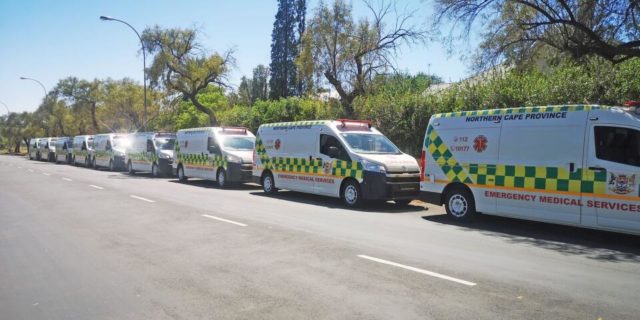Thirty emergency medical services vehicles – 20 ambulances and 10 patient transporter vehicles – were launched by the Northern Cape Department of Health on Tuesday.
THIRTY emergency medical services vehicles – 20 ambulances and 10 patient transporter vehicles – were launched by the Northern Cape Department of Health on Tuesday to assist with emergency cases in the Province.
The MEC for Health, Maruping Lekwene, said the new vehicles will enable emergency medical services (EMS) to respond faster to emergencies.
“This launch takes place where we have just identified the Omicron virus. However, people must not panic as more research is being conducted by researchers to give more accurate information. The Northern Cape emergency medical services have reached a critical stage in its development. Not only have the needs and expectations of our citizens increased beyond all recognition over the past 27 years, but also the developments in clinical knowledge and health technology have outpaced our ability to keep up with national norms and standards.
Thirdly, delivering an effective emergency medical service starts with finance and human resources. Resource levels have to be based on accurate demand analysis and must match the demand ‘around the clock’. This means having the right numbers of appropriately trained people and roadworthy, fully-equipped vehicles,” said Lekwene.
“The national norm for the ratio of emergency service vehicles per head of population is one emergency service vehicle to 10,000 citizens. This ratio works well in urban and semi-rural areas, as is the case in the Sol Plaatje Local Municipality. However, in the more rural municipalities, the Department of Health has had to increase this ratio in terms of more allocations of resources. We have moved towards the replacement of an EMS vehicle every two years or 250,000 kilometres, whichever comes first. In this Province, there are many ambulances that are significantly older than this and have travelled more than 300,000km.”
Lekwene added that personnel will also be increased.
“In order to staff these 137 emergency medical service vehicles currently operational to meet national norms, the department will immediately increase the number of emergency medical service personnel from 643 to 830 over the medium-term expenditure framework.
“We agree that there are solutions to all emergency medical services problems in the Province if we work together to produce a strategic direction to which we can all sign up, improve our systems and implement our processes.
“We will also agree that there is a need for considerable investment in staffing levels, as well as in our infrastructure, our control rooms, information and communications technology and a newer and better-specified fleet, among other things.”
The MEC said the ambulances will be distributed in all five districts of the Province.
Lekwene noted that the lack of proper requirements for EMS training poses a challenge for the department.
“The department is planning a new EMS base in the Kuruman Hospital premises. In the current financial year, the department, through the EMS College, has already enrolled 15 students on a one-year EMS programme for both staff and a designated number of qualifying matriculants. However, the challenge is that some of our youth and community members do not have the right subjects to enrol for the training. Trainees now need to be in possession of a Grade 12 certificate with mathematics and science in order to qualify. Our youth need to focus on those subjects in order to qualify and also make themselves employable.”
He urged the EMS personnel to take proper care of the vehicles and not to abuse any of the resources of the department.
“The important aspect we need to take into consideration is the fact that standards are important. There is a demonstrable relationship between fast response and good outcomes in life-threatening and serious emergencies. But we must also ensure our top-level goals are to provide a safe, clinically effective response to life-threatening and serious emergencies, a timely and safe service for patients with urgent health-care transport needs and access to appropriate information, advice and care for people who dial the emergency numbers but do not need an emergency response.
“We need to remember that it is expected of all employees to guard against damage and loss of state assets, as well as taking good care of equipment placed in these ambulances at all times to ensure their readiness to provide the service they are intended for,” Lekwene said.








